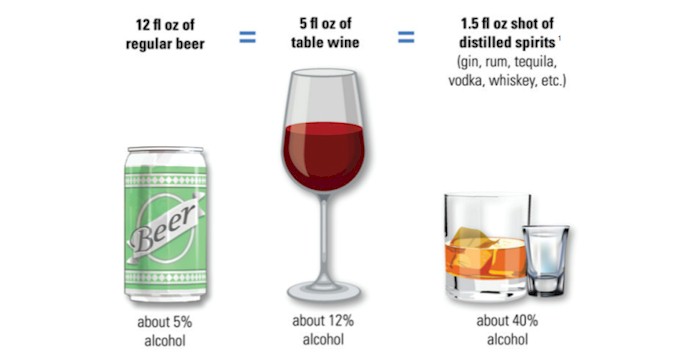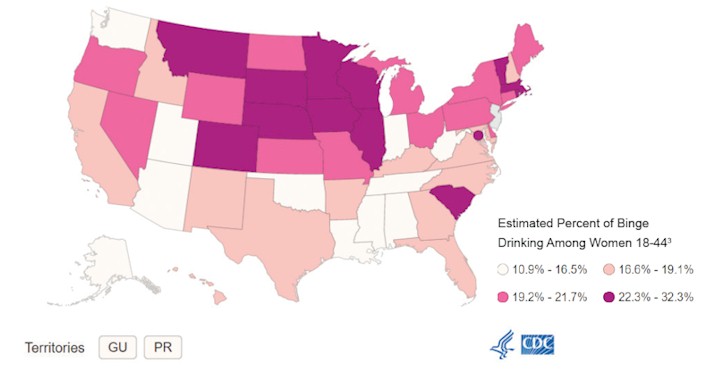Lesson 7
Lesson 9 Module 3
Introduction
In this next module, we will focus on a drug that is very commonly used by women: alcohol. We will
also discuss the important issue of alcohol use and pregnancy.


Discuss:
Let’s think about alcohol use in our culture and how alcohol use may become unhealthy or “risky” for both women and men.
Why Do Women Drink?
As we discussed earlier, there are a number of reasons how and why young women become involved in substance use. Some reasons may be familial or personal, some may be cultural, and some may be influenced by your peers or friends.
When we take a deeper dive into the reasons for substance use in women though, an important variable becomes clear: partner substance use. There seems to be a very important relationship between a young woman’s substance use, particularly alcohol use, and that of her significant other or romantic partner.
If someone's partner uses alcohol or drugs, then they are much more likely to become involved in use as well. Your significant other or romantic partner is a big predictor of whether or not you will use.
Think about a significant relationship in your life. How might that relationship be healthy or unhealthy for you when it comes to drug use? In a less healthy relationship, drug use may

become a way to spend time together, or to relax together. It may become something unique to the relationship between the two of you and take on a special meaning or bond for the two of you.
Did You Know:
Partner drinking is an important predictor of a woman’s drinking/drug use behavior.

Discuss:
Partner Substance Use: Have you ever felt like your alcohol use has been impacted by your relationship with a partner?"
Your Metabolism
Another important thing to consider is the differences in how women use and metabolize substances, particularly alcohol. When we talk about metabolizing something, we mean the way in which a substance is processed by the body. Because of the way women process alcohol, they cannot and should not use alcohol at the same level as a man. For many women, if their partner is using alcohol in an unhealthy way, they may be influenced to also use in ways that are unhealthy.
This idea of the differences in how men and women metabolize alcohol becomes very important when we begin to think about healthy versus unhealthy drinking levels.
The image below shows what is considered a “standard drink” and is based on what is called absolute alcohol levels. As you can see, what is considered a standard beer, a standard glass of wine, or a standard drink of hard alcohol is probably a lot less than you would think.
Are you surprised by these standard amounts? As I’m sure you know, we can and do have access to containers of alcohol that serve much larger quantities than these considered standard.


Discuss:
What constitutes a standard drink? Less than you might think: 5 ounces of wine, 12 ounces of beer, 1.5 ounces of hard alcohol.
What Constitutes “Risky” Drinking? Less than you might think
Let’s think about what is considered healthy versus unhealthy drinking, or “risky” drinking. This chart outlines the levels of alcohol use considered healthy vs. unhealthy for men and women at various
stages of their life. Once again, male/female differences in how our bodies use and metabolize alcohol are important.
What’s “at-risk” or “heavy” drinking?
For healthy adults in general, drinking more than these single-day or weekly limits is considered “at-risk” or “heavy” drinking.
Men: More than 4 drinks on any day or 14 per week.
Women: More than 3 drinks on any day or 7 per week.
About 1 in 4 people who exceed these limits already have alcohol use disorder. The rest are at greater risk for developing drinking disorders and other problems. Again, individual risks vary. People can have problems drinking less than these amounts, particularly if they drink too quickly.

ANY alcohol use is risky when: pregnant, driving, with certain medical conditions, when taking certain medications, when in recovery from addiction, when someone can’t control their drinking.
Did You Know:
It makes a difference both how much you drink on any day and how often you
have a “heavy drinking day,” that is, more than 4 drinks on any day for men or
more than 3 drinks for women.

Discuss:
Does the amount of alcohol use that’s considered risky or unhealthy surprise you?
What About a “Binge” For a Woman?
What do you think is the amount a young woman would need to drink to be considered a binge? Knowing what you now know about the different ways a woman’s body processes alcohol versus a man’s, do you think the amount of a binge is different for women and men?
A binge for a young woman is considered 4 or more drinks at a time, or in a “sitting” (sometimes quantified as a 2-hour “sitting”) and for a man a binge is 5 or more drinks at a time.
Next we will examine the issue of binge drinking and young women.


Discuss:
What do you think your friends consider binge drinking?
Estimated Percent of Binge Drinking Among Women 18-44
CDC conducts a series of surveys each year as part of the Behavioral Risk Factor Surveillance System, or BRFSS. Included is a survey in which they ask women of childbearing age - which for this survey is considered to be 18 to 44 years old - 2 questions: the first is whether they use alcohol at all and the second is whether they ever engage in binge drinking.
As we just discussed, for a woman a binge is 4 or more drinks in a sitting or usually within a 2-hour period of time. As you can see in Georgia, somewhere between 16.6% and 19.1% of women of childbearing age have engaged in binge drinking.
As I’m sure you know, binge drinking is a very risky behavior for everyone. Driving under the influence, motor vehicle crashes, other types of accidents like falls, and a higher risk for sexual assaults or domestic violence are all possible consequences when someone uses too much alcohol.
Additionally, we know about 50% of pregnancies are unplanned. Do you think the rate of unintended pregnancy might be higher with young women who binge drink? What about alcohol exposure to the fetus from an unintended pregnancy when binge drinking? These are all significant and serious issues for a young woman who may be struggling with the use of too much alcohol.


Discuss:
What do you think about the number of women binge drinking in this age group? Does this seem to be true for the people in your friend group?
What Are the Risks of Alcohol Use?
Injuries
Drinking too much increases your chances of being injured or even killed. For example, alcohol is a factor in about 40 percent of fatal burn injuries, 50 percent of fatal drownings and homicides, 29 percent of fatal motor vehicle crashes, 30 percent of suicides, 65 percent of fatal falls, and 30 percent of severe trauma injuries, as well as a significant number of sexual assaults. (4)
Health Problems
Drinking can cause a number of health problems. Studies have shown that one drink a day increases the risk of breast cancer in women. Research has also shown that people who drink excessively have a greater risk of

liver disease, heart disease, depression, stroke, and stomach bleeding, as well as cancers of the oral cavity, esophagus, larynx, pharynx, liver, colon, and rectum. They may also have problems managing conditions such as diabetes, high blood pressure, pain, and sleep disorders. They may also increase their chances for contracting sexually transmitted infections from unsafe sex.
Birth Defects
Drinking during pregnancy can cause brain damage and other serious problems in the baby. Because it is not yet known whether any amount of alcohol is safe for a developing baby, women who are pregnant or may become pregnant should not drink.
Alcohol Use Disorder
Alcohol use disorder is a medical condition that doctors can diagnose when a patient’s drinking causes distress or harm. In the United States, nearly 15 million people have alcohol use disorder.5

Discuss:
Beyond the physical and mental health risks, frequent heavy drinking is also linked with personal problems, including losing a driver’s license and having relationship troubles.
